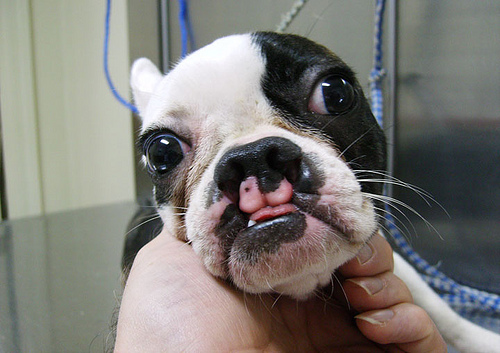If your dog were a book, it would be a book in cartoon format. Dogs are simple creatures - which do not mean they are simple-minded. They can only concentrate on one thing at a time. Short-term memory is so limited, that they do not know what the fuss is about if you try to punish them for something they did even a short time ago - such as mess up the lounge.
Although every dog is different and personalities among our canine friends almost as varied as among our human ones, there are certain signals which mean the same whichever dog is "saying" them. Learn to read them to avoid misunderstandings with your faithful friend. If your dog is looking at something, he is thinking about it. When looking at the door, for example, he is thinking about going out. When looking at the bin, he's thinking about a tasty morsel inside and whether he can get at it. By interpreting this simple body language, you can reward behaviours you wish to encourage - and filter out the rest.
Dogs are first and foremost social creatures. As a pack animal, he's going to behave with you as if you were a dog, if you are all the pack he has. Much of what the dog does is simply to stay in touch with his pack. If your dog puts any part of his body on top of you, he thinks he is the pack leader. In other words, he's more dominant than you. Test this thing out by lying or sitting on the floor next to him. If he puts his chin or paw on your leg, he thinks he's boss. To correct this impression, stand up and place him next to you in a sit position. If he then places a paw in front of your foot, he still thinks he's top dog. It is easy to correct this - just move him off you. He is not giving you a hard time but this is just his natural way. Lap dogs are slightly different in this respect and sitting on you does not mean they feel dominant.
Being top dog is not necessarily a problem for all dogs, but it can lead to separation anxiety (he is in the position of being your parent) and related complications, such as pulling on the lead, biting, running off, barking. One simple way to affirm yourself is to go through the doors before him. The pack leader does this, to check for danger.
A submissive dog is easy to spot - he will roll over and expose his underbelly to you - i.e. offer you his life. He may also pat you with his paw - not to be confused with putting a paw on you when lying down. A puppy will pat his mother when she returns, to ask for food. In other words, your dog is showing you he is dependent on you for food. When he licks you on the face that also means the same thing. Puppies will lick the faces and mouths of their elders to encourage them to regurgitate a juicy tidbit for them.
A wagging tail is not always a simple expression of delight - the dog is showing conflicting emotions and may be frightened. He is pleased to see you, but perhaps in the past you have been angry with him - as when he has trashed the place, or failed to come when called. He wants to come close to you, but he is a little scared to do so. His pack instinct will get the upper hand, so he probably will come to you. Wagging his tail, you should be wary of strange dogs wagging their tails, because in their confusion they may become aggressive.
When the dog stretches his front paws out so his bottom remains up in the air, he wants to play. Try doing the same back to him one day - he will get quite excited, even if you are just a human. Only do this, though, if you really intend to play with him.
A lot of doggie behaviour problems can be resolved by the dog getting the right amount of exercise for his breed.

 English Springer Spaniels
Introduction And HistoryWhet
English Springer Spaniels
Introduction And HistoryWhet
 Curing Your Dogs Separation Anxiety
Dog Anxiety is a Serious Iss
Curing Your Dogs Separation Anxiety
Dog Anxiety is a Serious Iss
 Cleft Palates and Cleft Lips in Puppies - Dog Health
Cleft Palates and Cleft Lips in Puppies
Cleft palates and
Cleft Palates and Cleft Lips in Puppies - Dog Health
Cleft Palates and Cleft Lips in Puppies
Cleft palates and
 How To Prepare For Getting Your First Puppy
So its that time in your lif
How To Prepare For Getting Your First Puppy
So its that time in your lif
 3 Tips to Stop your Dog from Pulling on the Leash While Walking and Keep Your Arms in Their Sockets
If you find walking your dog
3 Tips to Stop your Dog from Pulling on the Leash While Walking and Keep Your Arms in Their Sockets
If you find walking your dog